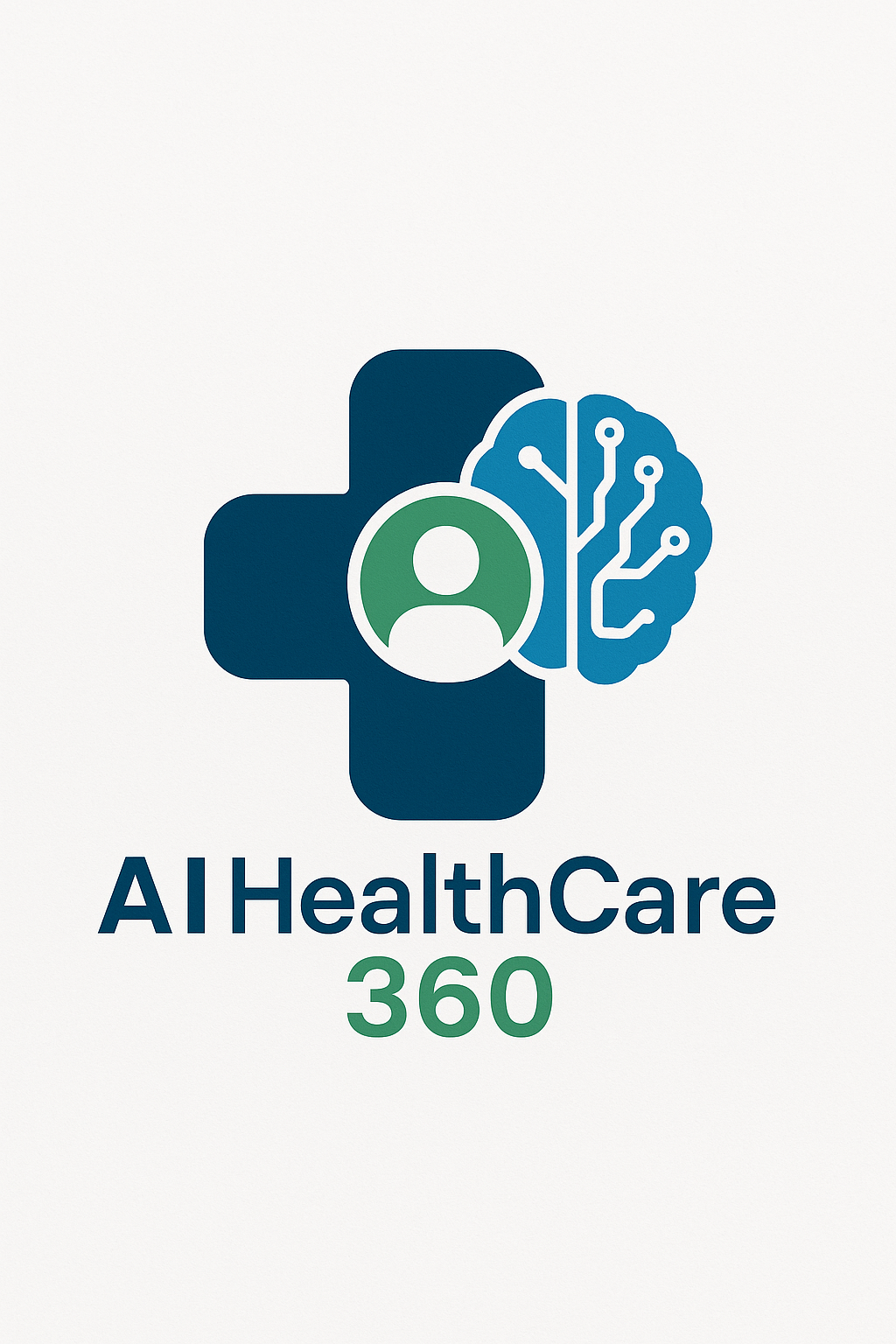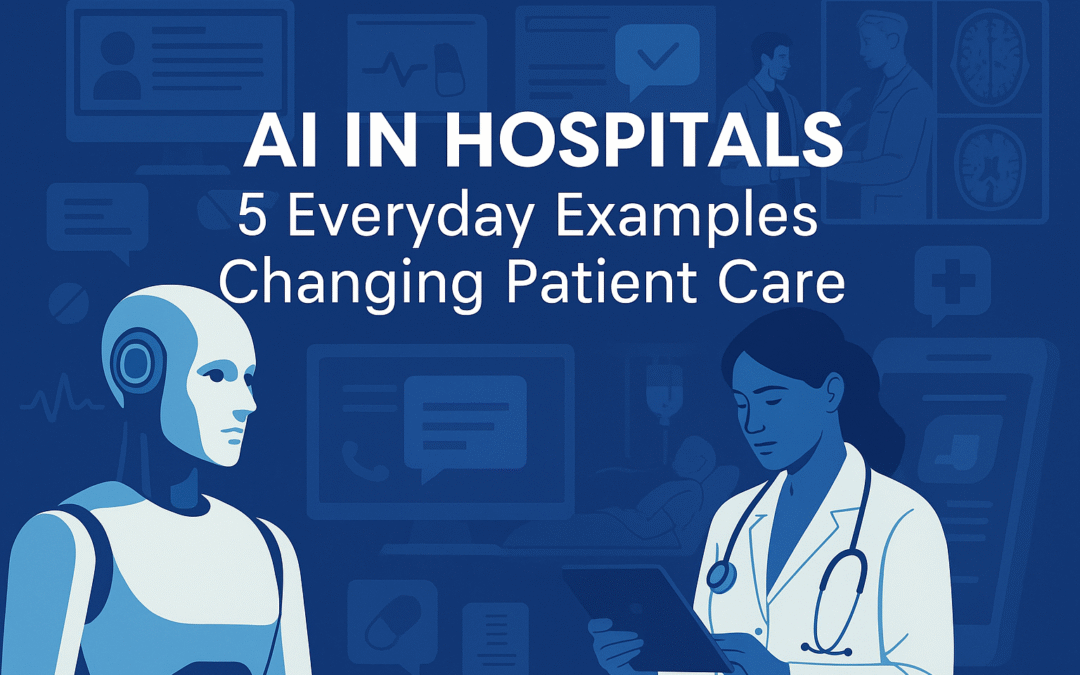Introduction
If you’ve filled out digital forms before a visit, chatted with a virtual nurse after hours, or noticed your clinician talking to you more and typing less, you’ve probably touched AI in hospitals already. These tools speed up paperwork, get faster answers for urgent issues, and remind you about medications or side effects—while clinicians stay in the loop to review and confirm decisions.
AI doesn’t replace doctors. Instead, it takes care of routine tasks and ensures patients get faster, safer, and more personal care. Below are five everyday examples of AI in hospitals that are already changing patient care, backed by U.S. case studies and authoritative sources.
Fast Facts: AI in Hospitals Today
-
AI scribes: Permanente Medical Group saved 15,791 hours in one year with ambient scribing across 2.5M uses. (AMA)
-
Digital intake: Phreesia processed 170M+ patient visits in 2024, about 1 in 7 across the U.S. (Phreesia/Business press)
-
24/7 care: Cedars-Sinai Connect (with K Health) supported 42,000+ patients in its first year with AI-guided virtual care. (Business Insider)
-
Imaging triage: Viz.ai stroke detection software, FDA-cleared in 2018, is now deployed in 1,600+ hospitals nationwide. (FDA / TIME)
-
Follow-up check-ins: UPenn’s “Penny” texts oral-chemo patients daily, alerting clinicians to side effects in real time. (AAMC)
Everyday AI in Hospitals: 5 Examples
1. AI Scribes Helping Doctors Focus on Patients
Typing into electronic records takes up huge amounts of clinicians’ time. AI scribes solve this by listening to visits (with consent), drafting the clinical note, and sending it back to the physician for review.
The results are measurable: The Permanente Medical Group reported saving 15,791 hours in a single year across 2.5 million uses. Cleveland Clinic also announced a system-wide rollout of Ambience Healthcare’s AI documentation platform, underscoring how major hospitals are betting on AI scribes to reduce burnout and improve patient interaction.
2. Digital Intake and E-Check-In Before Appointments
Clipboards and long front-desk lines are fading. Today, AI-enabled digital intake systems let patients fill out forms, verify insurance, and sign consents online before even entering the hospital.
This isn’t rare anymore: Phreesia, a leader in this space, managed over 170 million patient visits in 2024—roughly one in seven visits nationwide. If you’ve done pre-visit paperwork on your phone, you’ve already used hospital AI.
3. 24/7 Symptom Checkers and Virtual Care Access
Getting medical help outside office hours used to mean waiting until morning or heading to urgent care. Now, AI-powered symptom checkers gather your information, draft a likely plan, and then a licensed clinician reviews or adjusts it.
Cedars-Sinai Connect, powered by K Health, is a strong example. In its first year, it provided round-the-clock care to over 42,000 patients, combining AI-driven intake with physician oversight. That means patients get faster answers while doctors still stay in control.
4. Faster Imaging Triage for Emergencies
In emergencies like stroke, minutes matter. AI can analyze CT scans within minutes and automatically alert stroke specialists, allowing teams to act quickly.
The standout case is Viz.ai, the first AI stroke triage tool permitted by the FDA in 2018. Today, it’s deployed in more than 1,600 hospitals, making it one of the most widely used imaging AI platforms in the U.S.
5. Post-Visit AI Text Check-Ins for Safer Recovery
AI is also making follow-up care safer and more proactive. Patients may receive daily texts about medication adherence or side effects, with responses monitored by AI.
At the University of Pennsylvania’s Abramson Cancer Center, the “Penny” system checks in daily with oral-chemotherapy patients. It flags missed doses or worrying symptoms and alerts clinicians immediately. This helps catch problems early—before they become serious.
Benefits Patients and Clinicians Can See
-
More personal visits: AI scribes reduce typing, letting doctors focus on patients.
-
Shorter waits: digital intake speeds up check-in.
-
Faster help at night: symptom checkers connect patients to care 24/7.
-
Quicker stroke response: imaging AI saves critical minutes.
-
Safer recovery: text follow-ups catch side effects early.
Risks and How Hospitals Manage Them
-
Accuracy isn’t perfect: AI drafts or flags information, but clinicians confirm every decision.
-
Bias in data: hospitals test AI for fairness across different patient groups.
-
Privacy concerns: all systems must comply with HIPAA rules and secure sensitive data.
FAQs
1. How can I tell if my doctor is using an AI scribe?
You may notice them spending less time typing and more time talking to you. Hospitals disclose when ambient scribing is active, and doctors always review the notes.
2. Why am I asked to complete forms before my visit?
That’s an AI-enabled intake system. It saves time, reduces errors, and ensures smoother check-in.
3. Can I trust an AI symptom checker at night?
Yes—when it’s part of a hospital program. AI gathers and organizes your information, but licensed providers confirm the treatment plan.
4. If AI scans my CT, do doctors still review it?
Absolutely. AI tools like Viz.ai alert specialists quickly, but radiologists and stroke teams make the final call.
5. What if I don’t reply to hospital follow-up texts?
Systems like UPenn’s “Penny” will flag it and alert your care team, ensuring no patient slips through the cracks.
Conclusion
AI is no longer a future promise—it’s an everyday part of hospital care. From check-in to post-visit follow-ups, these tools improve efficiency, save time, and help catch problems earlier. Importantly, they work as assistants, not replacements, with doctors and nurses still in charge of care.
As hospitals expand their use of AI, patients can expect smoother experiences, safer monitoring, and faster answers—often without even realizing that AI is quietly at work in the background.
If you’re new to this topic, start with our foundation post What is AI in Healthcare for a complete overview

